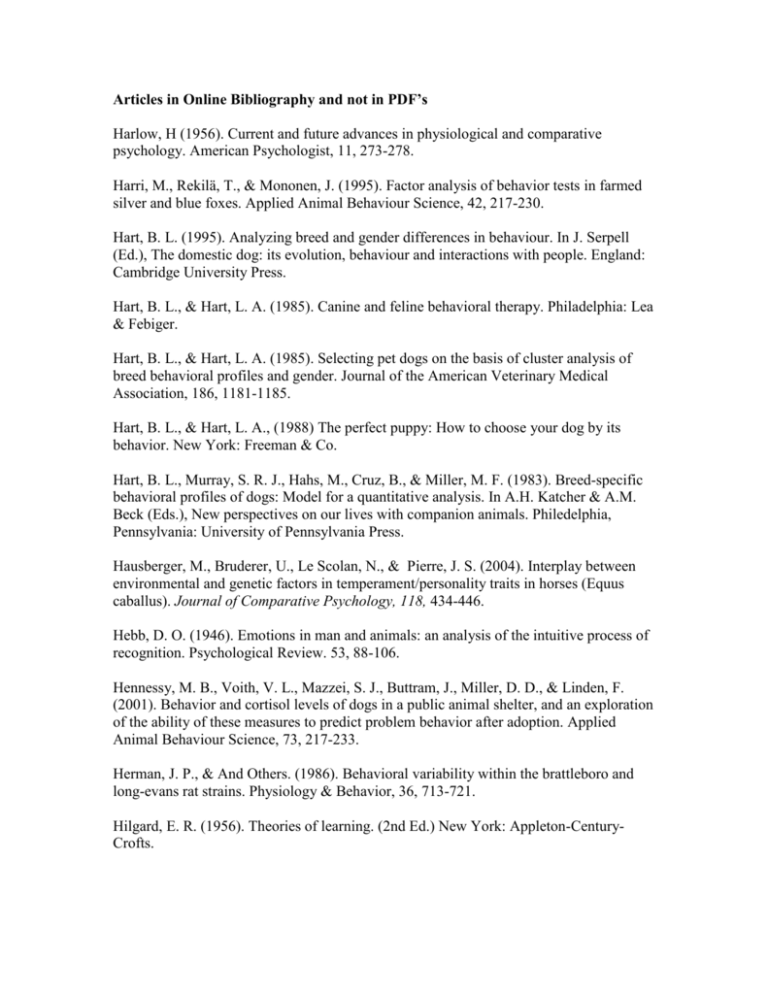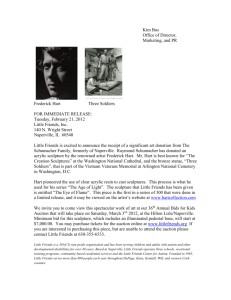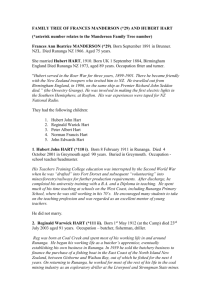Articles in Online Bibliography and not in PDF`s
advertisement

Articles in Online Bibliography and not in PDF’s Harlow, H (1956). Current and future advances in physiological and comparative psychology. American Psychologist, 11, 273-278. Harri, M., Rekilä, T., & Mononen, J. (1995). Factor analysis of behavior tests in farmed silver and blue foxes. Applied Animal Behaviour Science, 42, 217-230. Hart, B. L. (1995). Analyzing breed and gender differences in behaviour. In J. Serpell (Ed.), The domestic dog: its evolution, behaviour and interactions with people. England: Cambridge University Press. Hart, B. L., & Hart, L. A. (1985). Canine and feline behavioral therapy. Philadelphia: Lea & Febiger. Hart, B. L., & Hart, L. A. (1985). Selecting pet dogs on the basis of cluster analysis of breed behavioral profiles and gender. Journal of the American Veterinary Medical Association, 186, 1181-1185. Hart, B. L., & Hart, L. A., (1988) The perfect puppy: How to choose your dog by its behavior. New York: Freeman & Co. Hart, B. L., Murray, S. R. J., Hahs, M., Cruz, B., & Miller, M. F. (1983). Breed-specific behavioral profiles of dogs: Model for a quantitative analysis. In A.H. Katcher & A.M. Beck (Eds.), New perspectives on our lives with companion animals. Philedelphia, Pennsylvania: University of Pennsylvania Press. Hausberger, M., Bruderer, U., Le Scolan, N., & Pierre, J. S. (2004). Interplay between environmental and genetic factors in temperament/personality traits in horses (Equus caballus). Journal of Comparative Psychology, 118, 434-446. Hebb, D. O. (1946). Emotions in man and animals: an analysis of the intuitive process of recognition. Psychological Review. 53, 88-106. Hennessy, M. B., Voith, V. L., Mazzei, S. J., Buttram, J., Miller, D. D., & Linden, F. (2001). Behavior and cortisol levels of dogs in a public animal shelter, and an exploration of the ability of these measures to predict problem behavior after adoption. Applied Animal Behaviour Science, 73, 217-233. Herman, J. P., & And Others. (1986). Behavioral variability within the brattleboro and long-evans rat strains. Physiology & Behavior, 36, 713-721. Hilgard, E. R. (1956). Theories of learning. (2nd Ed.) New York: Appleton-CenturyCrofts. Hoffman, M. (1999). Lend me an ear: The temperament, selection, and training of the hearing ear dog. Wilsonville, OR: Doral Publishing. Holmes, A., Yang, R. J., Lesch, K., Crawley, J. N., & Murphy, D. L. (2003). Mice Lacking the Serotonin Transporter Exhibit 5-HT-sub(1A) Receptor-Mediated Abnormalities in Tests for Anxiety-like Behavior, Neuropsychopharmacology, 28, 20772088. Hooton, E. (1942). Man’s Poor Relations. New York: Doubleday. Hsu, Y., & Serpell, J. A. (2003). Development and validation of a questionnaire for measuring behavior and temperament traits in pet dogs. Journal of the American Veterinary Medical Association, 223, 1293–1300. Huntingford, F. A. (1990). Fear and the suppression of behavioural responses in fish. In P. F. Brain, S. Parmigiani, R. J. Blanchard, & D. Mainardi (Eds.), Fear And Defence. Ettore Majorana International Life Sciences Series, Vol. 8 (pp. 41-67). London: Harwood Academic Publishers. Huntingford, F., & Giles, N. (1987) Individual variation in anti-predator responses in the three-spined stickleback (Gasterosteus aculeatus L.) Ethology, 74, 205-210. Articles in PDF’s and not in Online Bibliography Hebb, 1956. The motivating effects of exteroceptive stimulation. (Abstract.) Hemsworth, Barnett, Hansen, & Gonyou 1986. The influence of early contact with humans on subsequent behavioral response of pigs to humans. Herzog & Shelley 1992. Animals, archetypes, and popular culture: Tales from the tabloid press. Herzog, 1990. Experimental modification of defensive behaviors in garter snakes. Herzog & Bailey, 1987. Development of antipredator responses in snakes: II. Effects of recent feeding on defensive behaviors of juvenile garter snakes. Herzog & Burghardt, 1986. Development of antipredator responses in snakes: I. Defensive and open-field behaviors in newborns and adults of three species of garter snakes. Herzog, Bowers & Burghardt, 1992. Development of antipredator responses in snakes: V. Species differences in ontogenetic trajectories. Hoeff, 1970. A component analysis of the structure of the social behavior of a semicaptive chimpanzee group. Hunt, 1998. Testosterone, estrogen, and breeding behavior in an arctic bird, the lapland longspur. Abstract. Van Hoof, 1973. A structural analysis of the structure of the social behavior of a semicaptive chimpanzee group.











